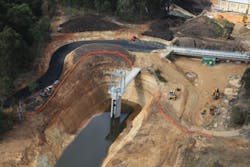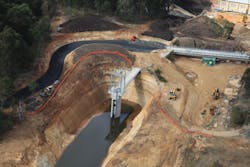Mardi Dam Upgrade Pumps Up Water Supply In Australia
In New South Wales, as part of the WaterPlan 2050, a multi-million upgrade to the Mardi Dam includes water transfer and lift pump systems. Bryan Orchard reports from Australia to see how the two pump stations have increased transfer capacity from 100,000 m3 to 160,000 m3 of treated water a day.
The New South Wales' central coast water supply system has undergone many improvements over its long lifetime. In recent decades improvement works have been almost continuous in response to population growth, changes in government regulations, varying climate conditions and new technologies.
In order to secure the water supply and protect the health of rivers, creeks and the environment Gosford City and Wyong Shire Councils have implemented a long-term strategy known as WaterPlan 2050.
This strategy is being realised through increasing the capacity of existing dams and extending the pipeline infrastructure to provide more effective water transportation.
One of the largest projects to have been undertaken in the past three years has been the Australian $45 million Mardi Dam Upgrade, which incorporates water transfer and high lift pump systems both of which have been equipped with KSB's RDLO pumps.
The Mardi Dam is an off-river storage dam located near the Wyong River and has a capacity of 7.4 million m3. The water transfer station pumps water from the dam to the nearby treatment works and the high lift station pumps water from the treatment works into the distribution network and associated pipeworks. Together with the construction of two tunnels, one 144m long with a diameter of 1.8m and the other 60m long with a diameter of 1.5m, plus 250m of large diameter pipework and associated valves, the two pump stations have increased transfer capacity from 100,000 m3 to 160,000 m3 of treated water a day.
The transfer pumping station has been equipped with three RDLO 600-600Aw pumps with 250kW motors and the high lift station with three RDLO 500-860Bw pumps with 1300kW motors. In both cases the pumps are in a two duty one standby configuration and each has a differential head of 18m and a capacity of 1010l/c. While both pump station can readily accommodate all current requirements, WaterPlan 2050 has made provision for each station to accommodate a fourth pump bringing the capacity up to 250,000 m3/day.
The new transfer system between the dam and the Mardi Water Treatment Plant MWTP) is capable of delivering 240,000 m3/day and allows for a possible future off-take to the Mangrove Creel Dam. The high lift pumping station is adjacent to the MWTP site and is capable of delivering up to 240,000 m3/day from the MWTP to the existing Tuggerah No.2 Reservoir and the Wyong distribution system.
Specified for the project by engineering contractors Baulderstone, the RDLO axially split, single stage volute pumps have been developed specifically for handling raw water, clean water, service water and transport fluids with a minimum of flow resistance. As a result, they lower the energy and life cycle costs of the systems in which they are installed.
Reliability results from the casing halves being sealed by solid casing split flanges at the upper and lower casing part, and high availability is attributable to the use of generously dimensioned bearings and high-quality shaft seals.
Smooth running is ensured at all times thanks to the flow-optimised, vortex-free intake elbow and rigid shaft with short bearing span. Because the shaft is completely sealed without steps/threads in the wetted area the RDL offers reliable power transmission. One example which is frequently encountered by KSB is where the specification for split casing pumps calls for studs on the flanges in order to align the top case to the bottom case. The KSB RDLO pump design does not require the presence of flange studs because the top case and lower case are self-aligning. Therefore all that is required are normal bolts, making installation and maintenance are much quicker and easier, and of course, there are no studs to get damaged.
Other major projects included in the WaterPlan 205 include:
- Increasing the capacity of Wyong River pump station from 72 million litres to 125,000 m3 litres of water a day.
- Building a connection from lower Mangrove Creek weir to Mooney Mooney Dam to enable the transfer of surplus water for storage.
The Councils also introduced additional sources of water to boost supplies, including the construction of the $37 million Hunter Connection which can deliver an annual daily average of 30,000 m3 of treated drinking water. This is as well as the development of seven groundwater bore fields across the Central Coast to generate around 9,000 m3 of treated drinking water.
The Mardi Dam Project has made the Central Coast water supply system far more flexible by improving the rate at which water can be transferred between the Wyong and Gosford water supply systems.
Author details: Bryan Orchard represents KSB. For more information, please visit: [email protected].


